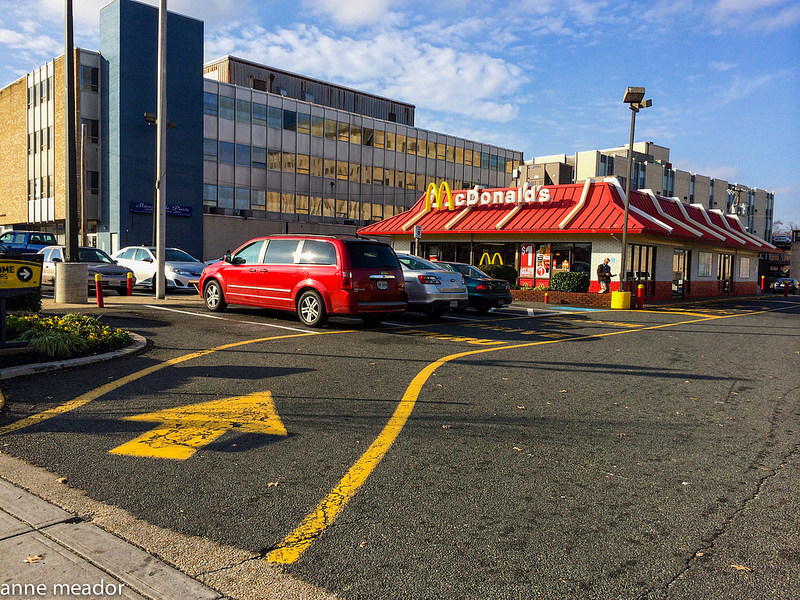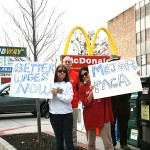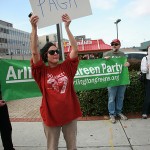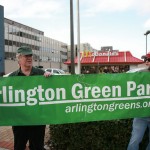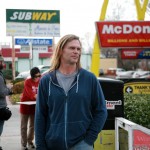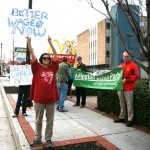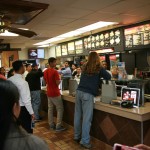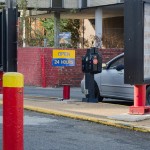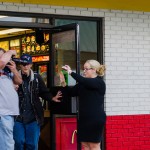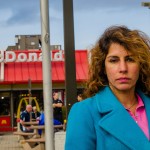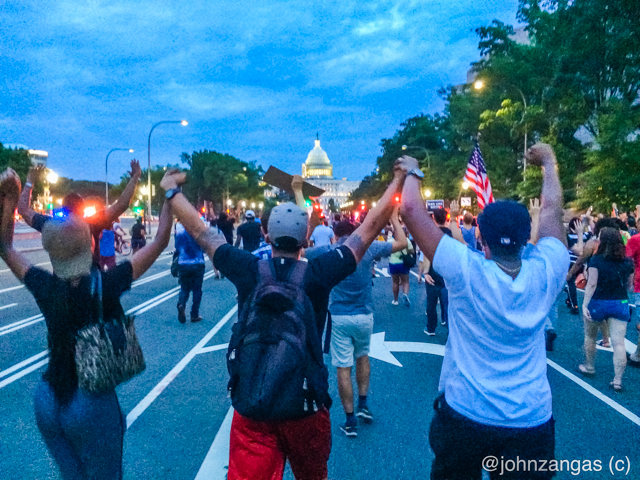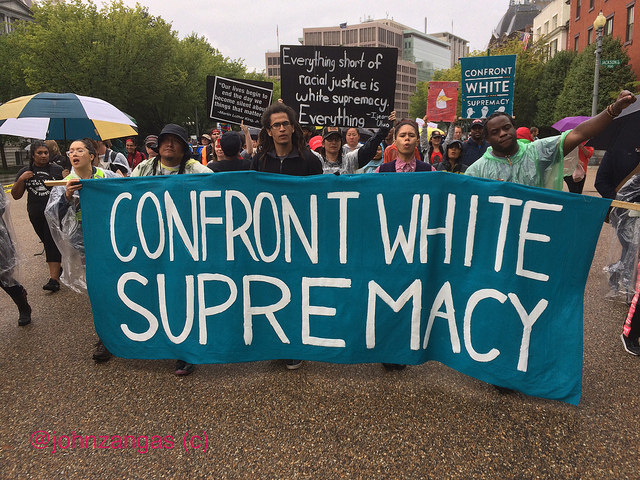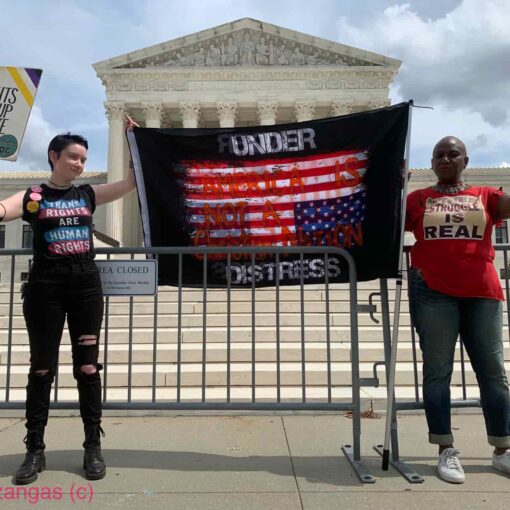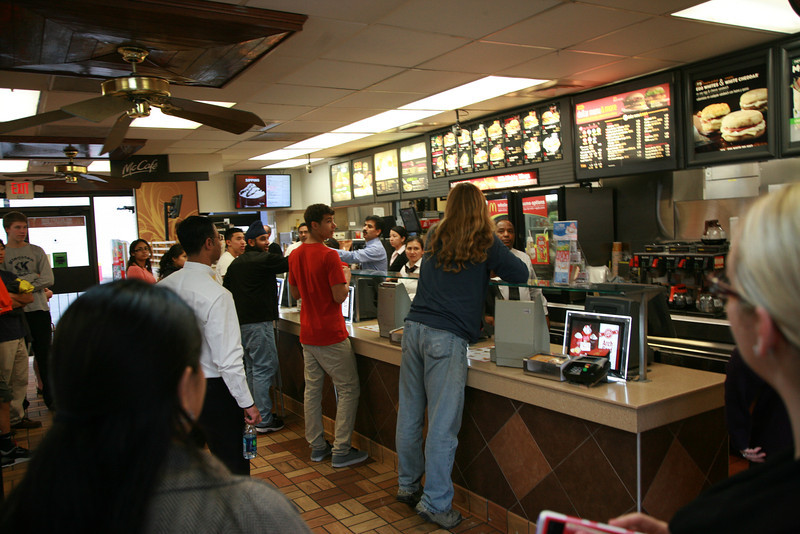
At the Columbia Pike McDonald’s in Arlington, VA on Thursday, all the elements were in place for a walkout of employees.
A public relations rep from McDonald’s corporate greeted reporters with a stiff smile and a warning to stay off the property when taking photos. A police car with two officers was positioned behind the neighboring 7-11. Local press was all over the place ready to video and photograph. Five members of the local Green Party showed up with a banner and signs saying, “Better Wages Now” and “Mejor Paga.”
According to the website publicizing the the National Strike and Protests Against Low Pay, Low Pay Is Not OK, there was a walkout of fast food workers scheduled at 2pm at the Columbia Pike McDonald’s.
Two o’clock came and went. No glass doors with double arches opened. Two-fifteen. No workers. Two-thirty.
An employee washed the inside of the plate glass facing street side.
It was one of many protests taking place–or supposed to be taking place–that day around the country. Earlier in the day, workers at the McDonald’s at the National Air and Space Museum in nearby Washington, DC walked out and joined supporters in a large rally.
“The protest is the latest in a series organized by groups like Fast Food Forward, Fight for 15 and Low Pay is Not OK, which are supported by the labor union giant Service Employees International Union,” Reuters reported. “The groups had to compensate the protesters for the day off they took, because many couldn’t afford…to lose it.”
So with corporate PR on the scene ready to deal with press–and presumably sic police on unruly protestors if necessary–where were the workers?
A man who had been sitting in front of the restaurant for more than an hour said at 1:15pm, he saw people walk around in a circle carrying signs for about 10 minutes.
The TV cameras wouldn’t arrive for another half hour.
DC Media Group wasn’t allowed inside the restaurant to get comment from employees, but protestors on the sidewalk in front of the McDonald’s had plenty to say about fast-food wages.
“You can’t survive on this,” said substitute teacher Naila Remington, whose first job was at that very McDonald’s when she was 17 years-old. She supposed that fear was the reason that the employees didn’t show up at the scheduled time. “They’re probably scared, they don’t want to lose their jobs,” she said.
“People just need to be working. They’re just not making it, and people are desperate,” she said, adding that wages hadn’t gone up in real terms since she worked there in the ’70s.
While many critics of raising the federal minimum wage say that only teenagers seeking spending money work at fast-food restaurants, Remington said that even decades ago it wasn’t like that. “My parents had financial difficulties,” she said. “I was on my own. I put myself through two years at NoVa [community college].”
Father Bob Richter, a Catholic priest from Our Lady Queen of Peace in Arlington, said it was a matter of values to stand by fast-food workers. “They are not commodities, they’re not machines,” he said. “I think it’s important for people to have a living wage, not only to have money, but money translates into food, shelter, healthcare, education for kids, transportation.”
He estimated that a living wage for Arlington would be about $15 an hour. “I’m not sure McDonald’s would be willing to do that,” he said. “Besides, they could pass the cost along to the customer.”
McDonald’s CEO Don Thompson received a pay increase of $4.1 million last spring, making his total yearly compensation $13.8 million. McDonald’s increased his pay package in spite of declining sales.
- Photo by Ted Majdosz
- Photo by Ted Majdosz
- Photo by Ted Majdosz
- Photo by Ted Majdosz
- Barry Knight /Photo by Ted Majdosz
- Photo by Ted Majdosz
- McDonald’s PR rep /Photo by Ted Majdosz
- Protestor Barry Knight tells McDonald’s employees they should walkout while press are present /Photo by Ted Majdosz
- Photo by John Zangas
- McDonald’s PR rep doesn’t want her picture taken
- Naila Remington, former McDonald’s employee

